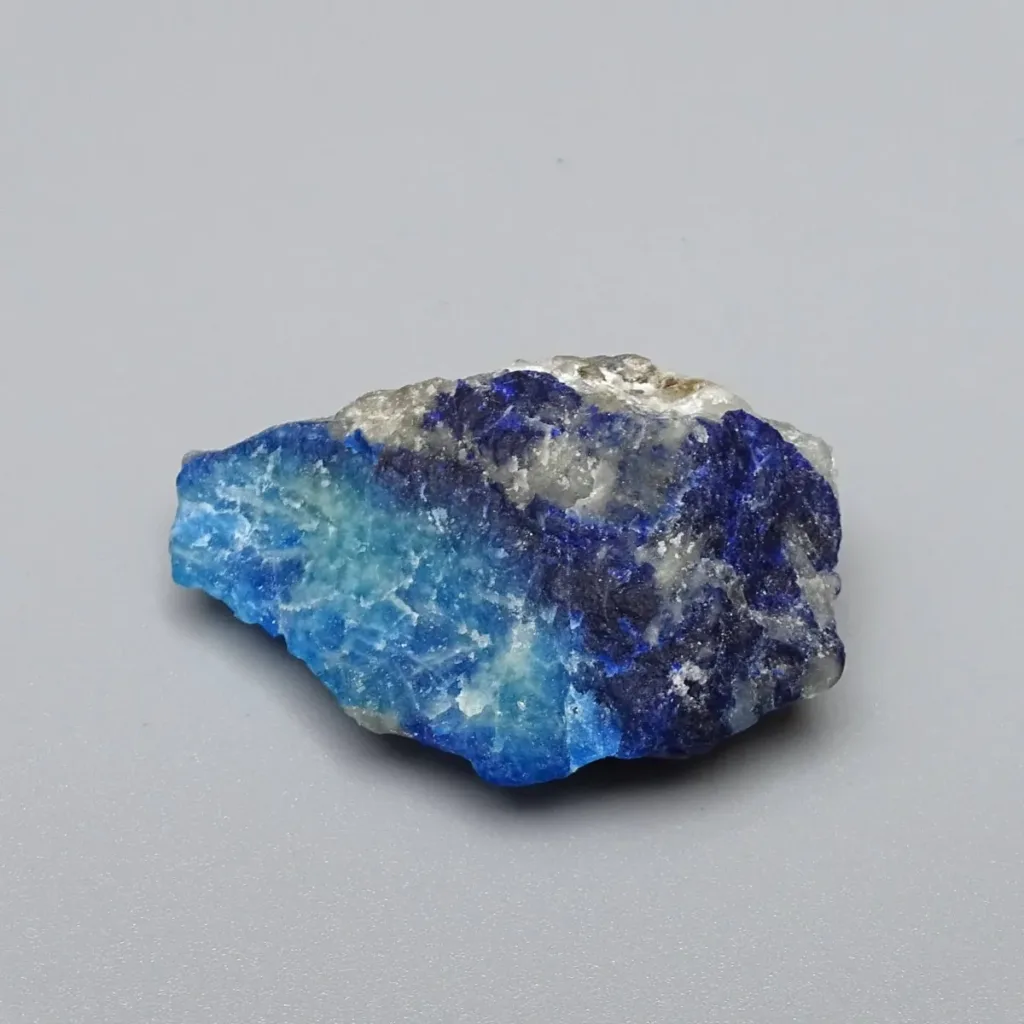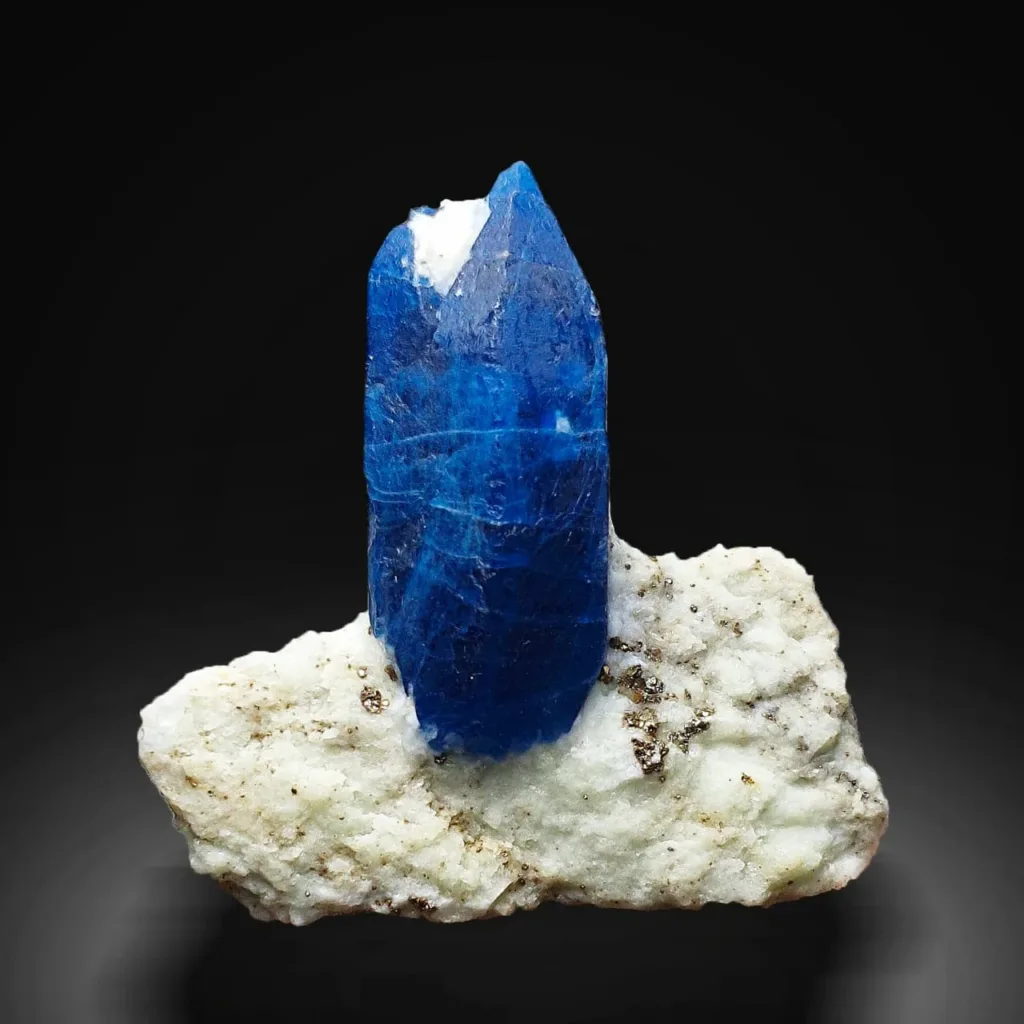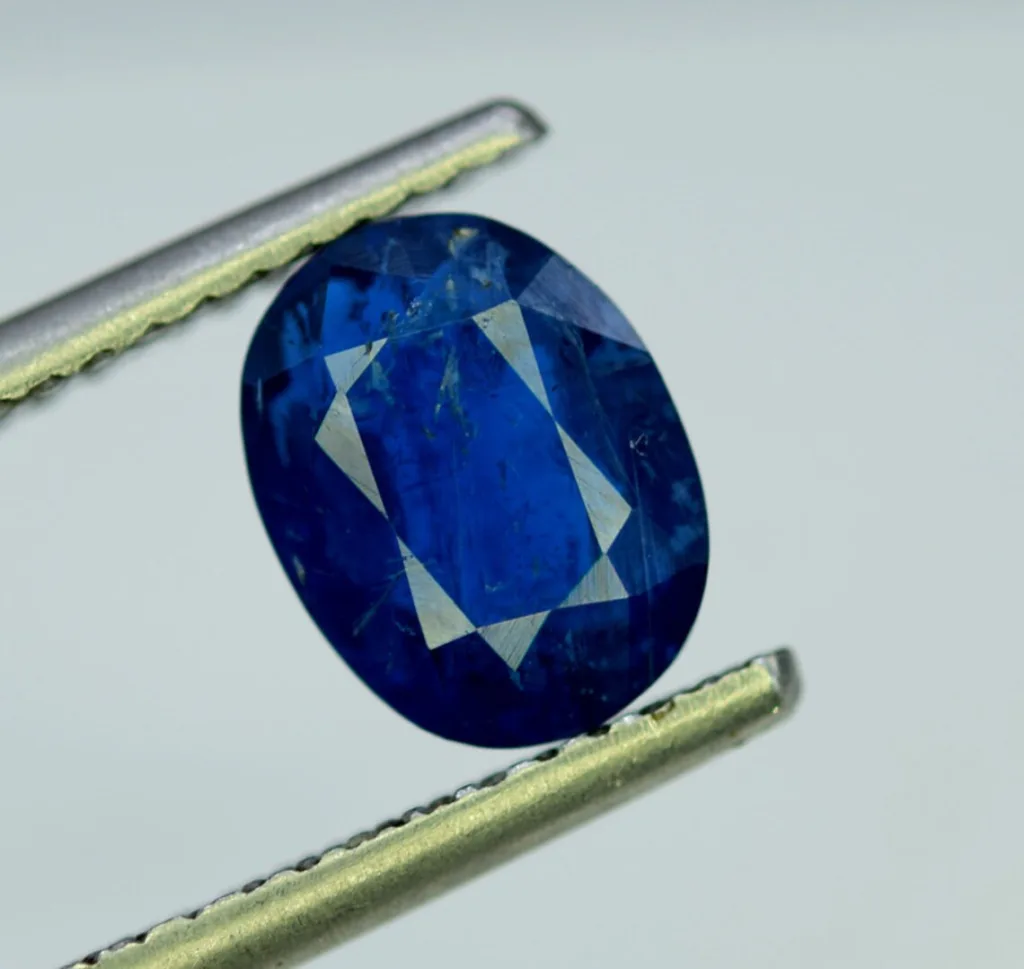Afghanite is a rare mineral that belongs to the silicate mineral group. It was first discovered in the early 1960s in the Sar-e-Sang district of Badakhshan Province in Afghanistan, hence its name. This mineral typically occurs in metamorphic rocks, particularly in contact metamorphic zones where limestones have been altered by the intrusion of igneous rocks.

Chemically, Afghanite is a complex mineral composed of sodium, calcium, aluminum, silicon, sulfur, and chlorine. Its chemical formula is typically written as (Na,Ca)8(Si,Al)12O24(SO4,Cl)2, indicating its varying composition. Afghanite often forms as prismatic crystals, though it can also occur in massive or granular forms.
One notable characteristic of Afghanite is its vibrant blue color, which can range from pale to deep blue. This striking coloration, along with its rarity, makes Afghanite a sought-after mineral among collectors and enthusiasts.
In addition to its aesthetic appeal, Afghanite has been studied for its crystal structure and mineralogical significance. It belongs to the sodalite group of minerals, which share similar crystal structures characterized by large cavities filled with smaller ions and molecules.
While Afghanite is primarily found in Afghanistan, it has also been discovered in other locations around the world, including Russia, Italy, the United States, and Canada, albeit in much smaller quantities. Despite its scarcity, Afghanite continues to be of interest to mineralogists, geologists, and collectors due to its unique properties and beautiful appearance.
Physical Properties of Afghanite

The physical properties of Afghanite contribute to its identification and distinguish it from other minerals. Here are some key physical properties:
- Color: Afghanite typically exhibits a range of blue hues, from pale to deep blue. However, it can also occur in colors such as white, gray, or greenish-blue.
- Luster: Afghanite has a vitreous to greasy luster, giving it a shiny or somewhat oily appearance when light reflects off its surface.
- Transparency: Afghanite is usually translucent to opaque, meaning that light can pass through it but not clearly enough to see through it completely.
- Crystal System: Afghanite crystallizes in the tetragonal crystal system, meaning its crystals have fourfold rotational symmetry around one axis. The crystals are typically prismatic in shape.
- Hardness: Afghanite has a Mohs hardness of around 5.5 to 6.5, making it moderately hard. This means it can scratch glass but can be scratched by harder materials such as steel.
- Cleavage: Afghanite typically exhibits poor cleavage in one direction, meaning it does not readily split along smooth, flat surfaces.
- Fracture: The fracture of Afghanite is typically uneven to conchoidal, meaning it breaks with irregular or curved surfaces.
- Density: The density of Afghanite varies depending on its composition, but it typically has a density ranging from 2.5 to 2.6 grams per cubic centimeter.
These physical properties, along with its chemical composition, help geologists and mineralogists identify Afghanite specimens in the field and laboratory settings.
Occurrence and Formation

Afghanite is primarily found in metamorphic rocks, particularly in contact metamorphic zones where limestone has been altered by the intrusion of igneous rocks. It occurs in association with other minerals such as diopside, calcite, and pyrite. The mineral was first discovered in the Sar-e-Sang district of Badakhshan Province in Afghanistan, but it has also been found in other regions around the world, albeit in smaller quantities.
The formation of Afghanite is closely linked to the geological processes of metamorphism and metasomatism. Metamorphism refers to the process by which rocks undergo changes in mineralogy, texture, or chemical composition due to changes in temperature, pressure, or the introduction of fluids. Metasomatism involves the alteration of rocks through the addition or removal of chemical elements by fluids circulating through the Earth’s crust.
In the case of Afghanite, its formation is thought to occur during the metamorphism of carbonate-rich rocks, such as limestone or dolomite, in the presence of fluids rich in sodium, calcium, aluminum, sulfur, and chlorine. These fluids, which may be derived from the intrusion of igneous rocks or from other geological processes, interact with the host rocks, causing the alteration of mineral compositions and the formation of new minerals such as Afghanite.
The exact conditions under which Afghanite forms can vary, but it generally requires elevated temperatures and pressures typical of metamorphic environments, as well as the presence of specific chemical components necessary for its crystallization. The formation of Afghanite may also be influenced by factors such as the duration of metamorphic processes, the composition of the parent rocks, and the availability of fluid sources.
Overall, Afghanite’s occurrence and formation are closely tied to the complex geological processes that shape the Earth’s crust, making it a fascinating subject of study for geologists and mineralogists interested in understanding the planet’s history and mineral diversity.
Physical Properties of Afghanite

Certainly! Here’s a more detailed overview of the physical properties of Afghanite:
- Color: Afghanite typically exhibits shades of blue ranging from pale to deep blue. It can also occur in white, gray, or greenish-blue varieties.
- Luster: The luster of Afghanite is typically described as vitreous to greasy, giving it a shiny or somewhat oily appearance when light reflects off its surface.
- Transparency: Afghanite is usually translucent to opaque, meaning that light can pass through it, but not clearly enough to see through it completely.
- Crystal System: Afghanite crystallizes in the tetragonal crystal system, meaning its crystals have fourfold rotational symmetry around one axis. The crystals are typically prismatic in shape.
- Hardness: Afghanite has a Mohs hardness of around 5.5 to 6.5, making it moderately hard. This means it can scratch glass but can be scratched by harder materials such as steel.
- Cleavage: Afghanite typically exhibits poor cleavage in one direction, meaning it does not readily split along smooth, flat surfaces.
- Fracture: The fracture of Afghanite is typically uneven to conchoidal, meaning it breaks with irregular or curved surfaces.
- Density: The density of Afghanite varies depending on its composition, but it typically has a density ranging from 2.5 to 2.6 grams per cubic centimeter.
These physical properties help geologists and mineralogists identify Afghanite specimens and distinguish them from other minerals.
Geological Deposits

Afghanite is primarily found in metamorphic rocks, particularly in contact metamorphic zones where limestone or carbonate-rich rocks have been altered by the intrusion of igneous rocks. The mineral was first discovered in the Sar-e-Sang district of Badakhshan Province in Afghanistan, where it occurs in association with other minerals such as diopside, calcite, and pyrite.
While Afghanistan remains the most significant locality for Afghanite, it has also been found in other regions around the world, though in smaller quantities. Some notable occurrences include:
- Russia: Afghanite has been reported in the Khibiny Massif on the Kola Peninsula in Russia, where it occurs in alkaline igneous rocks associated with minerals such as nepheline, sodalite, and aegirine.
- Italy: In Italy, Afghanite has been found in the Piedmont region, particularly in the vicinity of the Lanzo Valley. Here, it occurs in metamorphic rocks associated with calcite, diopside, and pyrite.
- United States: Afghanite has been reported in several locations in the United States, including California, Montana, and Colorado. In California, Afghanite has been found in metamorphic rocks associated with serpentinite in the Clear Creek area.
- Canada: Afghanite occurrences have also been reported in Canada, particularly in Quebec and Ontario. In Quebec, Afghanite has been found in metamorphic rocks associated with the Grenville Province.
Overall, Afghanite deposits are primarily associated with metamorphic environments where carbonate-rich rocks have undergone alteration in the presence of fluids enriched with sodium, calcium, aluminum, sulfur, and chlorine. These deposits provide valuable insights into the geological processes that have shaped the Earth’s crust over millions of years.
Associated Minerals Chemical Composition

Associated Minerals: Afghanite is often found in association with various minerals depending on the specific geological environment in which it forms. Some common minerals found alongside Afghanite include:
- Diopside: A calcium magnesium silicate mineral commonly found in metamorphic and igneous rocks.
- Calcite: A carbonate mineral that often occurs in sedimentary, metamorphic, and igneous rocks.
- Pyrite: An iron sulfide mineral commonly found in a variety of geological environments, including sedimentary, metamorphic, and igneous rocks.
- Sodalite: Another member of the sodalite group of minerals, sodalite is a sodium aluminum silicate chloride mineral often occurring in igneous rocks.
- Nepheline: A sodium potassium aluminosilicate mineral commonly found in alkaline igneous rocks.
Chemical Composition: The chemical composition of Afghanite can vary somewhat, but it is generally described by the following formula: (Na,Ca)8(Si,Al)12O24(SO4,Cl)2. This formula indicates the variability in the composition of Afghanite, with substitutions of sodium (Na) and calcium (Ca) for each other, as well as substitutions of silicon (Si) and aluminum (Al) for each other. Additionally, Afghanite may contain either sulfate (SO4) or chloride (Cl) ions.
The presence of these chemical elements and ions contributes to Afghanite’s distinctive properties and appearance. The varying compositions and associations of Afghanite with other minerals provide valuable information about the geological processes that lead to its formation in different environments.
Uses and Applications

Afghanite, due to its rarity and specific properties, does not have widespread commercial uses like more common minerals. However, it is valued in certain niche applications and industries. Here are some potential uses and applications of Afghanite:
- Gemstone: Afghanite’s striking blue color and rarity make it desirable among collectors and lapidaries. It can be cut and polished into gemstones for use in jewelry, although its scarcity limits its availability in the market.
- Mineral Specimen: Afghanite specimens are sought after by mineral collectors and museums due to their beauty and rarity. They are often displayed in mineral collections and used for educational purposes.
- Research and Study: Afghanite is of interest to mineralogists, geologists, and researchers studying mineral formations and geological processes. Its occurrence in specific geological environments provides insights into metamorphism and metasomatism.
- Metaphysical and Spiritual Uses: Some individuals believe that certain minerals, including Afghanite, possess metaphysical properties and healing energies. As such, Afghanite may be used in spiritual practices, meditation, or crystal healing.
While Afghanite may not have practical industrial applications, its aesthetic appeal, rarity, and geological significance ensure that it remains valued among collectors, researchers, and enthusiasts.




































